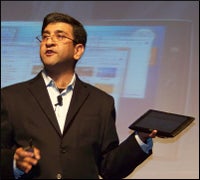 |
| Pankaj Kedia, director of global ecosystem programs for mobile Internet devices at Intel Photo: David Needle |
SAN FRANCISCO — Every day, an estimated 100,000 new Web sites are created around the world.
That was one of several staggering statistics served up by Intel’s Pankaj Kedia here in his keynote kicking off the GigaOM Mobilize conference.
A few others: Yahoo’s photo-sharing site Flickr has four billion images; Facebook users post a billion photos every month; there are 30 billion searches on Google every day.
So, yes, the Internet — as Donald Trump might say — is huge and growing like crazy.
And as Intel (NASDAQ: INTC) sees it, one area in particular is poised to reap much of the benefit: mobile.
“Our vision is that there will be a billion personal mobile computers in the world over the next few years,” Kedia said.
These devices, he quipped, also happen to make phone calls.
He also noted the number of mobile handsets worldwide is closing in on 6 billion, with many consumers owning more than one device. Additionally, Kedia pointed to the rapid proliferation and dropping costs of Internet-enabled devices like netbooks as furthering the cause of mobile connectivity.
“Some netbooks are free [subsidized by a wireless carrier in return for a contract], or $399 or $499, and everything in between,” he said. “There’s a lot of experimentation going on around the world.”
Such trends have serious implications for Intel’s efforts to cash in through its mobile Internet device group, which Kedia directs.
During his presentation, Kedia demonstrated a range of devices including a netbook that fit easily in the palm of his hand — while emphasizing that each new device offers the same interactive features, like access to Web sites and services as desktop PCs.
A PC-like Web experience in your pocket
Yet he also made a point of emphasizing Intel’s view that the Internet or Web experience should be viewed as the same regardless of whether the user is on a PC, notebook or mobile device.
“The bottom line is that the WAP Internet, the text Internet, the slow Internet and the subset of Internet that I can hardly see on the small screen is a thing of the past,” Kedia said. “The PC Internet, the real Internet, is coming to all these devices.”
Still, that’s not to say the experience of using the Web will be the same regardless of device.
“We think there’s a lot of room for innovation in the [user interface] space and how you interact with the device,” he said.
For instance, Kedia said that a number of popular activities play to mobile’s strength. People’s interest in real-time search and updating their status online is better addressed by “pocketable” devices that are always with you.
“You don’t always have time to go to your PC at home,” he said.


